Agricultural Drought Hazard Using Satellite-Based Indices for Drought Risk Mapping in Koel River Basin (India) Through Geospatial Technologies
Abstract
1. Introduction
2. Study Area
3. Material and Methods
3.1. NDVI Anomaly and Drought Indices
3.2. Agricultural Drought Hazard Assessment
3.3. Drought Hazard Based on Indices
3.4. Village-Wise Socioeconomic Vulnerability (SEV) Mapping
3.5. Drought Risk Mapping
3.6. Drought Hazard and Risk Assessment
4. Results and Discussion
4.1. NDVI Anomaly and Drought Indices
NDVI Anomaly
4.2. Drought Indices
4.3. Spatio-Temporal Annual Drought Extent Map During 2000–2023
4.4. Drought Hazard
4.5. Socioeconomic Vulnerability (SEV) and Drought Risk Map
4.6. Drought and Risk Impact on Sub-Watersheds
5. Conclusions
Author Contributions
Funding
Institutional Review Board Statement
Informed Consent Statement
Data Availability Statement
Acknowledgments
Conflicts of Interest
Abbreviations
| GDP | Gross Domestic Product. |
| GWP | Ground Water Prospect |
| LST | Land Surface Temperature |
| MODIS | Moderate Resolution Imaging Spectroradiometer |
| GEE | Google Earth Engine |
| SOI | Survey of India. |
| SVE | Socio Economic Vulnerability Index |
| SEDAC | Socio Economic Data and Application Centre |
| SPI | Standardized Precipitation Index |
| TCI | Temperature Condition Index |
| USGS | United States Geological Survey |
| VCI | Vegetation Condition Index |
| VHI | Vegetation Health Index |
References
- Wilhite, D.A.; Glantz, M.H. Understanding: The Drought Phenomenon: The Role of Definitions. Water Int. 1985, 10, 111–120. [Google Scholar] [CrossRef]
- Islam, M.S. Cultivation and Drought Management in Agriculture; Springer: Berlin/Heidelberg, Germany, 2023; ISBN 3-031-35418-4. [Google Scholar]
- Agegnehu, G.; Bass, A.M.; Nelson, P.N.; Muirhead, B.; Wright, G.; Bird, M.I. Biochar and biochar-compost as soil amendments: Effects on peanut yield, soil properties and greenhouse gas emissions in tropical North Queensland, Australia. Agric. Ecosyst. Environ. 2015, 213, 72–85. [Google Scholar] [CrossRef]
- Gupta, A.K.; Tyagi, P.; Sehgal, V.K. Drought disaster challenges and mitigation in India: Strategic appraisal. Curr. Sci. 2011, 100, 1795–1806. [Google Scholar]
- Mohammed-Aslam, M.A.; Rokhmatuloh, R.T.; Salem, Z.E.; Javzandulam, T. Linear mixture model applied to the land-cover classification in an alluvial plain using Landsat TM data. J. Environ. Inform. 2015, 7, 95–101. [Google Scholar] [CrossRef]
- Das, S.K.; Gupta, R.K.; Varma, H.K. Flood and drought management through water resources development in India. Bull. World Meteorol. Organ. 2007, 56, 179–188. [Google Scholar]
- Cooley, S.; Schoeman, D.; Bopp, L.; Boyd, P.; Donner, S.; Kiessling, W.; Martinetto, P.; Ojea, E.; Racault, M.F.; Rost, B. Oceans and coastal ecosystems and their services. In Climate Change 2022: Impacts, Adaptation and Vulnerability; Cambridge University Press: Cambridge, UK, 2023. [Google Scholar]
- Tripathi, O.P. Village level inherent vulnerability of Champhai district to climate change: Water Resources Approach. Indian J. Appl. Pure Bio. Vol. 2025, 40, 664–677. [Google Scholar]
- Alam, M.K.; Dasgupta, S.; Barua, A.; Ravindranath, N.H. Assessing climate-relevant vulnerability of the Indian Himalayan Region (IHR): A district-level analysis. Nat. Hazards 2022, 112, 1395–1421. [Google Scholar] [CrossRef]
- Field, C.B.; Barros, V.R. Climate Change 2014–Impacts, Adaptation and Vulnerability: Regional Aspects; Cambridge University Press: Cambridge, UK, 2014; ISBN 1-107-05816-3. [Google Scholar]
- Birkmann, J.; Liwenga, E.; Pandey, R.; Boyd, E.; Djalante, R.; Gemenne, F.; Leal Filho, W.; Pinho, P.; Stringer, L.; Wrathall, D. Poverty, livelihoods and sustainable development. In Climate Change 2022: Impacts, Adaptation and Vulnerability; Cambridge University Press: Cambridge, UK, 2023. [Google Scholar]
- Who, O. Overweight. 2013. Available online: https://www.who.int/en/news-room/fact-sheets/detail/obesity-and-overweight (accessed on 22 September 2022).
- Hao, Z.; Singh, V.P. Drought characterization from a multivariate perspective: A review. J. Hydrol. 2015, 527, 668–678. [Google Scholar] [CrossRef]
- Krueger, E.S.; Ochsner, T.E.; Brorsen, B.W. Soil moisture information improves drought risk protection provided by the USDA livestock forage disaster program. Bull. Am. Meteorol. Soc. 2024, 105, E1153–E1169. [Google Scholar] [CrossRef]
- Wang, Z.; Zhong, R.; Lai, C.; Zeng, Z.; Lian, Y.; Bai, X. Climate change enhances the severity and variability of drought in the Pearl River Basin in South China in the 21st century. Agric. For. Meteorol. 2018, 249, 149–162. [Google Scholar] [CrossRef]
- Rajsekhar, D.; Singh, V.P.; Mishra, A.K. Integrated drought causality, hazard, and vulnerability assessment for future socioeconomic scenarios: An information theory perspective. J. Geophys. Res. Atmos. 2015, 120, 6346–6378. [Google Scholar] [CrossRef]
- Tzanakakis, V.A.; Paranychianakis, N.V.; Angelakis, A.N. Water Supply and Water Scarcity; MDPI: Basel, Switzerland, 2020; Volume 12, ISBN 2073-4441. [Google Scholar]
- Sehgal, V.K.; Dhakar, R. Geospatial approach for assessment of biophysical vulnerability to agricultural drought and its intra-seasonal variations. Environ. Monit. Assess. 2016, 188, 197. [Google Scholar] [CrossRef]
- Rahman, M.R.; Lateh, H. Meteorological drought in Bangladesh: Assessing, analysing and hazard mapping using SPI, GIS and monthly rainfall data. Environ. Earth Sci. 2016, 75, 1026. [Google Scholar] [CrossRef]
- Vittal, H.; Karmakar, S.; Ghosh, S.; Murtugudde, R. A comprehensive India-wide social vulnerability analysis: Highlighting its influence on hydro-climatic risk. Environ. Res. Lett. 2020, 15, 014005. [Google Scholar]
- Bisht, D.S.; Chatterjee, C.; Kalakoti, S.; Upadhyay, P.; Sahoo, M.; Panda, A. Modeling urban floods and drainage using SWMM and MIKE URBAN: A case study. Nat. Hazards 2016, 84, 749–776. [Google Scholar] [CrossRef]
- Dalezios, N.R.; Blanta, A.; Spyropoulos, N.V.; Tarquis, A.M. Risk identification of agricultural drought for sustainable agroecosystems. Nat. Hazards Earth Syst. Sci. 2014, 14, 2435–2448. [Google Scholar] [CrossRef]
- Kogan, F. World droughts in the new millennium from AVHRRbased vegetation health indices. Eos Trans. Am. Geophys. Union 2002, 83, 557–563. [Google Scholar] [CrossRef]
- Alahacoon, N.; Matheswaran, K.; Pani, P.; Amarnath, G. A decadal historical satellite data and rainfall trend analysis (2001–2016) for flood hazard mapping in Sri Lanka. Remote Sens. 2018, 10, 448. [Google Scholar] [CrossRef]
- Islam, M.M.; Sado, K. Development of flood hazard maps of Bangladesh using NOAA-AVHRR images with GIS. Hydrol. Sci. J. 2000, 45, 337–355. [Google Scholar] [CrossRef]
- Belabid, N.; Zhao, F.; Brocca, L.; Huang, Y.; Tan, Y. Near-real-time flood forecasting based on satellite precipitation products. Remote Sens. 2019, 11, 252. [Google Scholar] [CrossRef]
- Sahoo, S.; Jha, M.K.; Kumar, N.; Chowdary, V.M. Evaluation of GIS-based multicriteria decision analysis and probabilistic modeling for exploring groundwater prospects. Environ. Earth Sci. 2015, 74, 2223–2246. [Google Scholar] [CrossRef]
- Tripathi, G.; Parida, B.R.; Pandey, A.C. Spatio-temporal rainfall variability and flood prognosis analysis using satellite data over North Bihar during the August 2017 flood event. Hydrology 2019, 6, 38. [Google Scholar] [CrossRef]
- Bhuiyan, C. Various drought indices for monitoring drought condition in Aravalli terrain of India. In Proceedings of the XXth ISPRS Congress, Istanbul, Turkey, 12–23 July 2004; pp. 12–23. [Google Scholar]
- Chaudhary, S.; Pandey, A.C. Multiple indices based drought analysis by using long term climatic variables over a part of Koel river basin, India. Spat. Inf. Res. 2019, 28, 273–285. [Google Scholar] [CrossRef]
- Heim, R.R., Jr. A review of twentieth-century drought indices used in the United States. Bull. Am. Meteorol. Soc. 2002, 83, 1149–1166. [Google Scholar] [CrossRef]
- Murthy, C.S.; Sesha Sai, M.V.R.; Kumari, V.B.; Roy, P.S. Agricultural drought assessment at disaggregated level using AWiFS/WiFS data of Indian Remote Sensing satellites. Geocarto Int. 2007, 22, 127–140. [Google Scholar] [CrossRef]
- Adeyeri, O.E.; Akinsanola, A.A.; Ishola, K.A. Investigating surface urban heat island characteristics over Abuja, Nigeria: Relationship between land surface temperature and multiple vegetation indices. Remote Sens. Appl. Soc. Environ. 2017, 7, 57–68. [Google Scholar] [CrossRef]
- Ogunjobi, K.O.; Adamu, Y.; Akinsanola, A.A.; Orimoloye, I.R. Spatio-temporal analysis of land use dynamics and its potential indications on land surface temperature in Sokoto Metropolis, Nigeria. R. Soc. Open Sci. 2018, 5, 180661. [Google Scholar] [CrossRef]
- Sruthi, S.; Aslam, M.M. Agricultural drought analysis using the NDVI and land surface temperature data; a case study of Raichur district. Aquat. Procedia 2015, 4, 1258–1264. [Google Scholar] [CrossRef]
- Kogan, F.N. Global drought watch from space. Bull. Am. Meteorol. Soc. 1997, 78, 621–636. [Google Scholar] [CrossRef]
- Parthasarathy, B.; Kumar, K.R.; Munot, A.A. Homogeneous Indian monsoon rainfall: Variability and prediction. Proc. Indian Acad. Sci. Earth Planet. Sci. 1993, 102, 121–155. [Google Scholar] [CrossRef]
- Patra, P.K.; Behera, S.K.; Herman, J.R.; Maksyutov, S.; Akimoto, H.; Yamagata, Y. The Indian summer monsoon rainfall: Interplay of coupled dynamics, radiation and cloud microphysics. Atmos. Chem. Phys. 2005, 5, 2181–2188. [Google Scholar] [CrossRef]
- Singh, R.P.; Roy, S.; Kogan, F. Vegetation and temperature condition indices from NOAA AVHRR data for drought monitoring over India. Int. J. Remote Sens. 2003, 24, 4393–4402. [Google Scholar] [CrossRef]
- Jha, R.K.; Gundimeda, H. An integrated assessment of vulnerability to floods using composite index–A district level analysis for Bihar, India. Int. J. Disaster Risk Reduct. 2019, 35, 101074. [Google Scholar] [CrossRef]
- Singh, G.R.; Jain, M.K.; Gupta, V. Spatiotemporal assessment of drought hazard, vulnerability and risk in the Krishna River basin, India. Nat. Hazards 2019, 99, 611–635. [Google Scholar] [CrossRef]
- Mishra, R.K. Fresh water availability and its global challenge. Br. J. Multidiscip. Adv. Stud. 2023, 4, 1–78. [Google Scholar] [CrossRef]
- Basheer Ahammed, K.K.; Pandey, A.C. Coastal social vulnerability and risk analysis for cyclone hazard along the Andhra Pradesh, East Coast of India. KN-J. Cartogr. Geogr. Inf. 2019, 69, 285–303. [Google Scholar] [CrossRef]
- Phongsapan, K.; Chishtie, F.; Poortinga, A.; Bhandari, B.; Meechaiya, C.; Kunlamai, T.; Aung, K.S.; Saah, D.; Anderson, E.; Markert, K. Operational flood risk index mapping for disaster risk reduction using earth observations and cloud computing technologies: A case study on Myanmar. Front. Environ. Sci. 2019, 7, 191. [Google Scholar] [CrossRef]
- Goswami, B.N.; Venugopal, V.; Sengupta, D.; Madhusoodanan, M.S.; Xavier, P.K. Increasing trend of extreme rain events over India in a warming environment. Science 2006, 314, 1442–1445. [Google Scholar] [CrossRef]
- Tirkey, A.S.; Ghosh, M.; Pandey, A.C.; Shekhar, S. Assessment of climate extremes and its long term spatial variability over the Jharkhand state of India. Egypt. J. Remote Sens. Space Sci. 2018, 21, 49–63. [Google Scholar] [CrossRef]
- Cruz, R.V. Asia. In Climate Change 2007: Impact, Adaptation and Vulnerability; Contribution of Working Group II to the Fourth Assessment Report of the Intergovernmental Panel on Climate Change; Cambridge University Press: Cambridge, UK, 2007; pp. 469–506. [Google Scholar]
- Izrael, Y.; Anokin, Y.; Eliseev, A.D. Final Report of the Russian Country Study on Climate Problem, Russian Federal Service for Hydrometeorology and Environmental Monitoring. In Vulnerability and Adaptation A Ssessments; Roshydromet: Moscow, Russia, 1997; Volume 3, Task 3. [Google Scholar]
- Ramos, M.C.; Balasch, J.C.; Martínez-Casasnovas, J.A. Seasonal temperature and precipitation variability during the last 60 years in a Mediterranean climate area of Northeastern Spain: A multivariate analysis. Theor. Appl. Climatol. 2012, 110, 35–53. [Google Scholar] [CrossRef]
- Pandey, S.; Pandey, A.C.; Nathawat, M.S.; Kumar, M.; Mahanti, N.C. Drought hazard assessment using geoinformatics over parts of Chotanagpur plateau region, Jharkhand, India. Nat. Hazards 2012, 63, 279–303. [Google Scholar] [CrossRef]
- Minj, H.P. Social dimension of climate change on tribal societies of Jharkhand. Int. J. Soc. Sci. Interdiscip. Res. 2013, 2, 34–41. [Google Scholar]
- Anyamba, A.; Tucker, C.J. Historical perspective of AVHRR NDVI and vegetation drought monitoring. Remote Sens. Drought Innov. Monit. Approaches 2012, 23, 20. [Google Scholar]
- Vaani, N.; Porchelvan, P. Monitoring of Agricultural Drought Using Fortnightly Variation of Vegetation Condition Index (vci) for the State of Tamil Nadu, India. Int. Arch. Photogramm. Remote Sens. Spat. Inf. Sci. 2018, 42, 159–164. [Google Scholar] [CrossRef]
- Amalo, L.F.; Hidayat, R. Comparison between remote-sensing-based drought indices in east java. In Proceedings of the IOP Conference Series: Earth and Environmental Science; IOP Publishing: Bristol, UK, 2017; Volume 54, p. 012009. [Google Scholar]
- Saha, S. Groundwater potential mapping using analytical hierarchical process: A study on Md. Bazar Block of Birbhum District, West Bengal. Spat. Inf. Res. 2017, 25, 615–626. [Google Scholar] [CrossRef]
- Koley, S.; Jeganathan, C. Evaluating the climatic and socio-economic influences on the agricultural drought vulnerability in Jharkhand. Environ. Monit. Assess. 2023, 195, 8. [Google Scholar] [CrossRef]
- Cutter, S.L.; Boruff, B.J.; Shirley, W.L. Social vulnerability to environmental hazards. In Hazards Vulnerability and Environmental Justice; Routledge: London, UK; New York, NY, USA, 2012; pp. 115–132. [Google Scholar]
- Pandey, R.; Kumar, P.; Singh, R.K. Socio-economic vulnerability and adaptation in tribal Jharkhand. J. Rural. Stud. 2022, 90, 66–75. [Google Scholar]
- Upadhyay, M.; Sherly, M.A. Multivariate framework for integrated drought vulnerability assessment—An application to India. Int. J. Disaster Risk Reduct. 2023, 85, 103515. [Google Scholar] [CrossRef]
- Chaudhary, S.; Pandey, A.C. PCA driven watershed prioritization based on runoff modeling and drought severity assessment in parts of Koel river basin, Jharkhand (India). Water Supply 2022, 22, 2034–2054. [Google Scholar] [CrossRef]
- Jeet, P.; Singh, K.N.; Kumar, R.R.; Gurung, B.; Singh, A.K.; Upadhyaya, A. Modeling and Trend Analysis of Climatic Variables of Ranchi District, Jharkhand. J. AgriSearch 2000, 8, 120–128. [Google Scholar] [CrossRef]

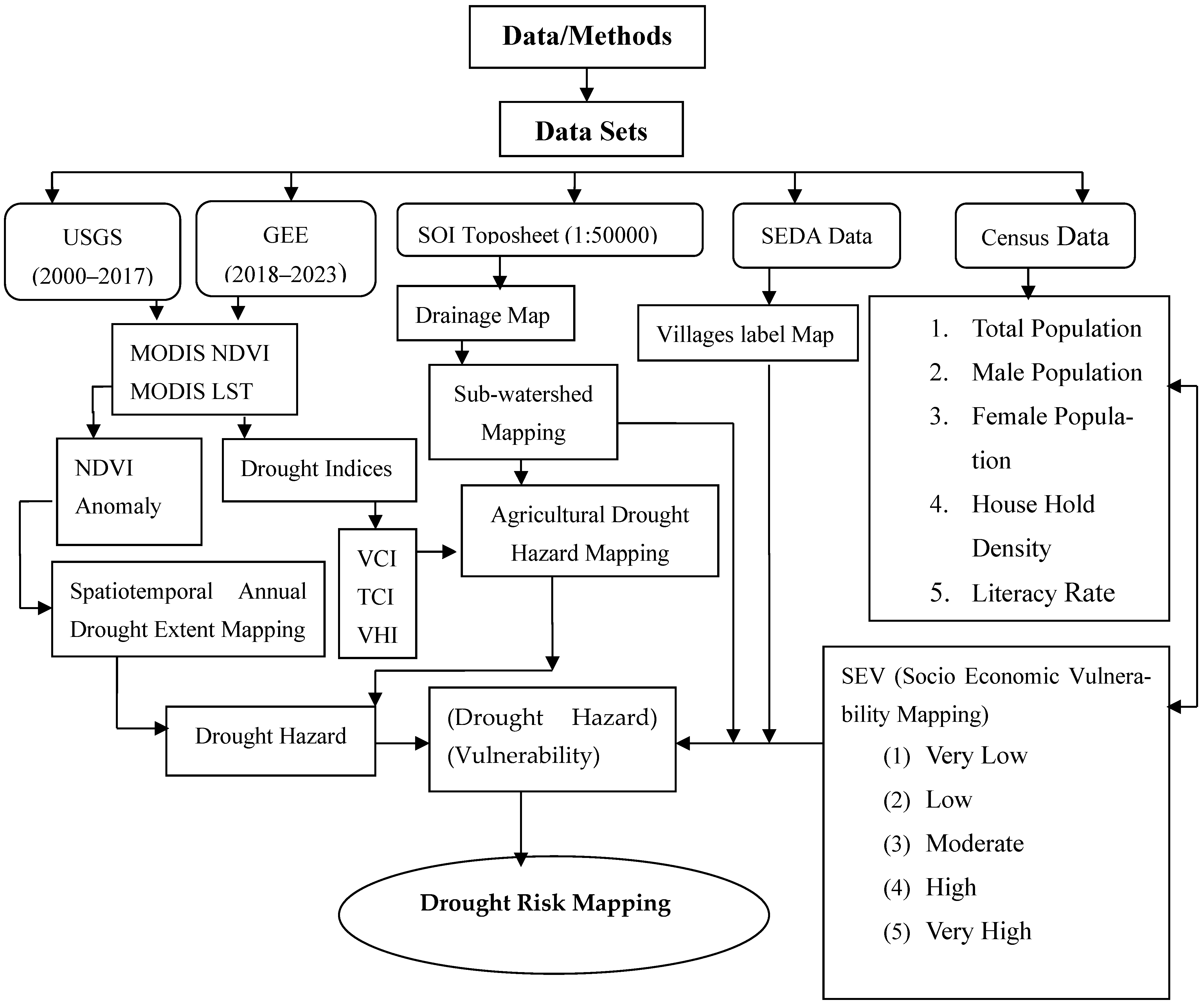
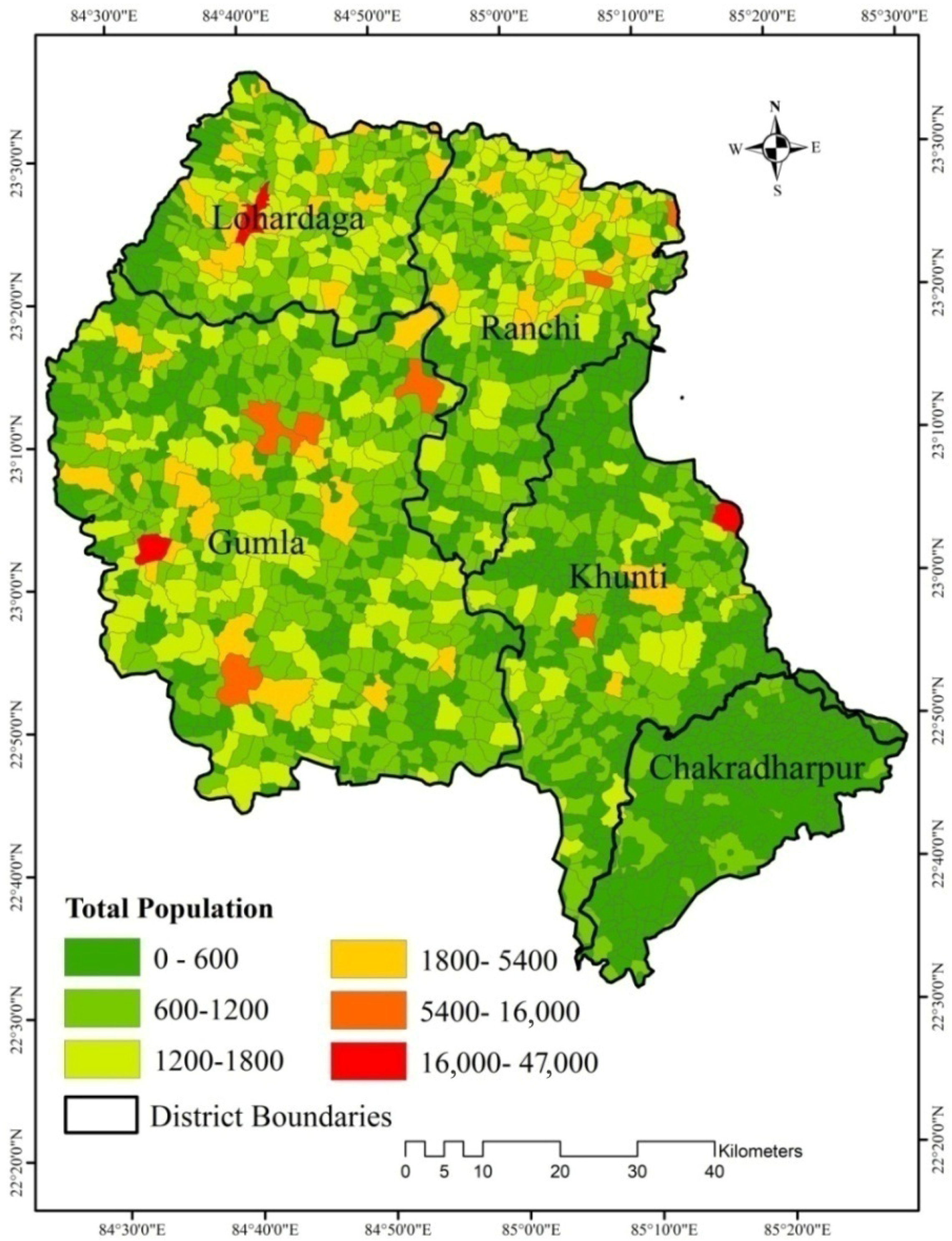
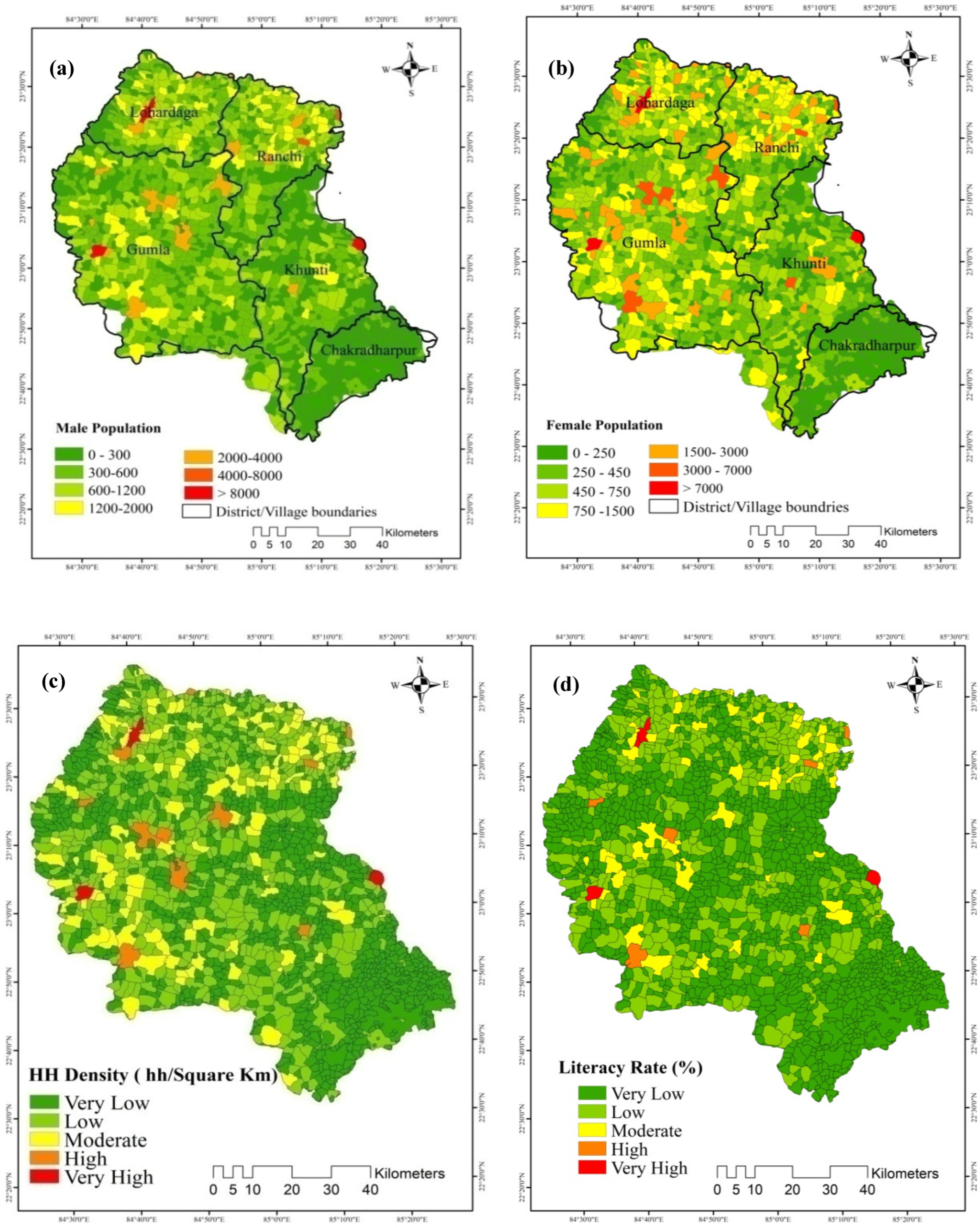
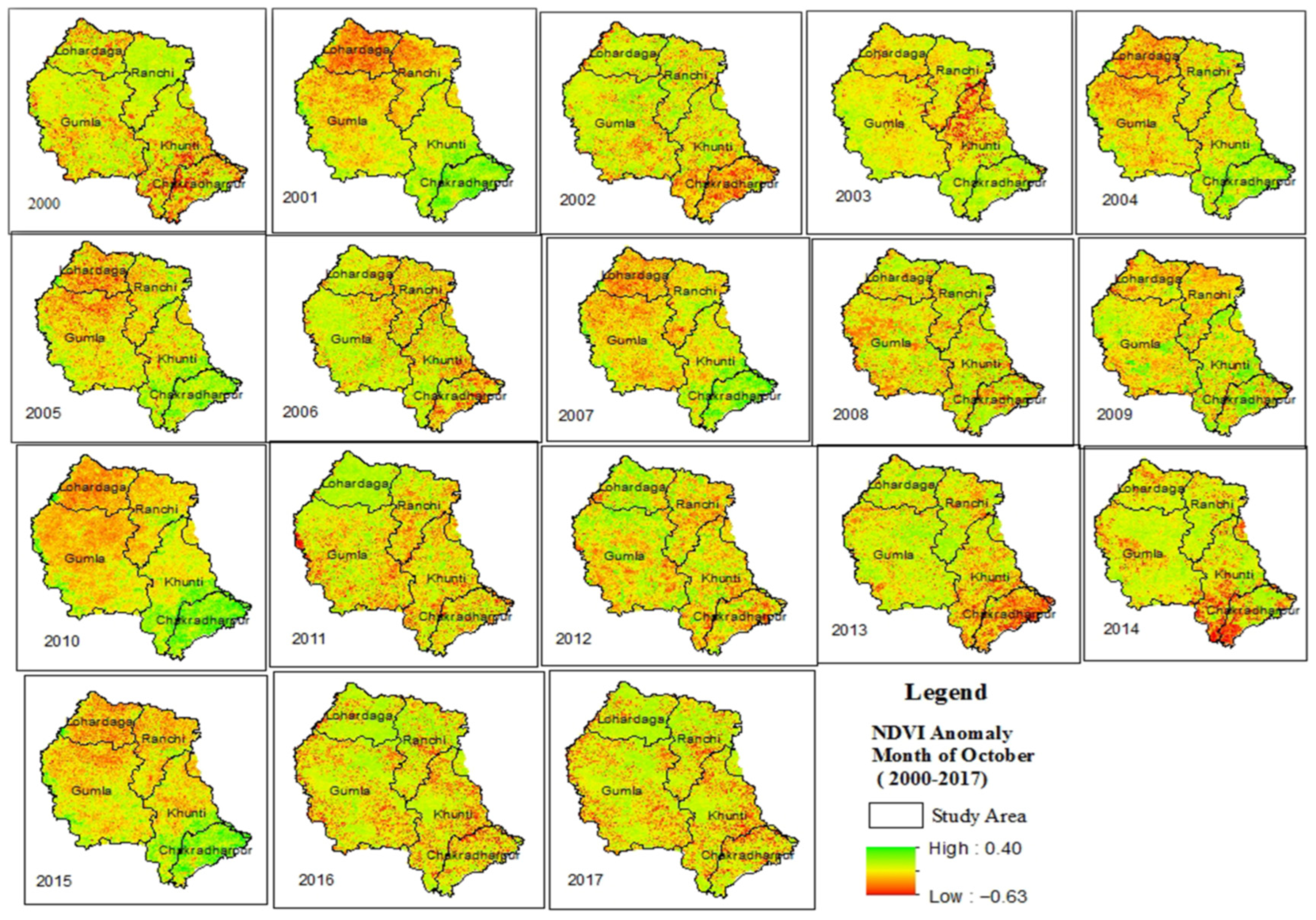
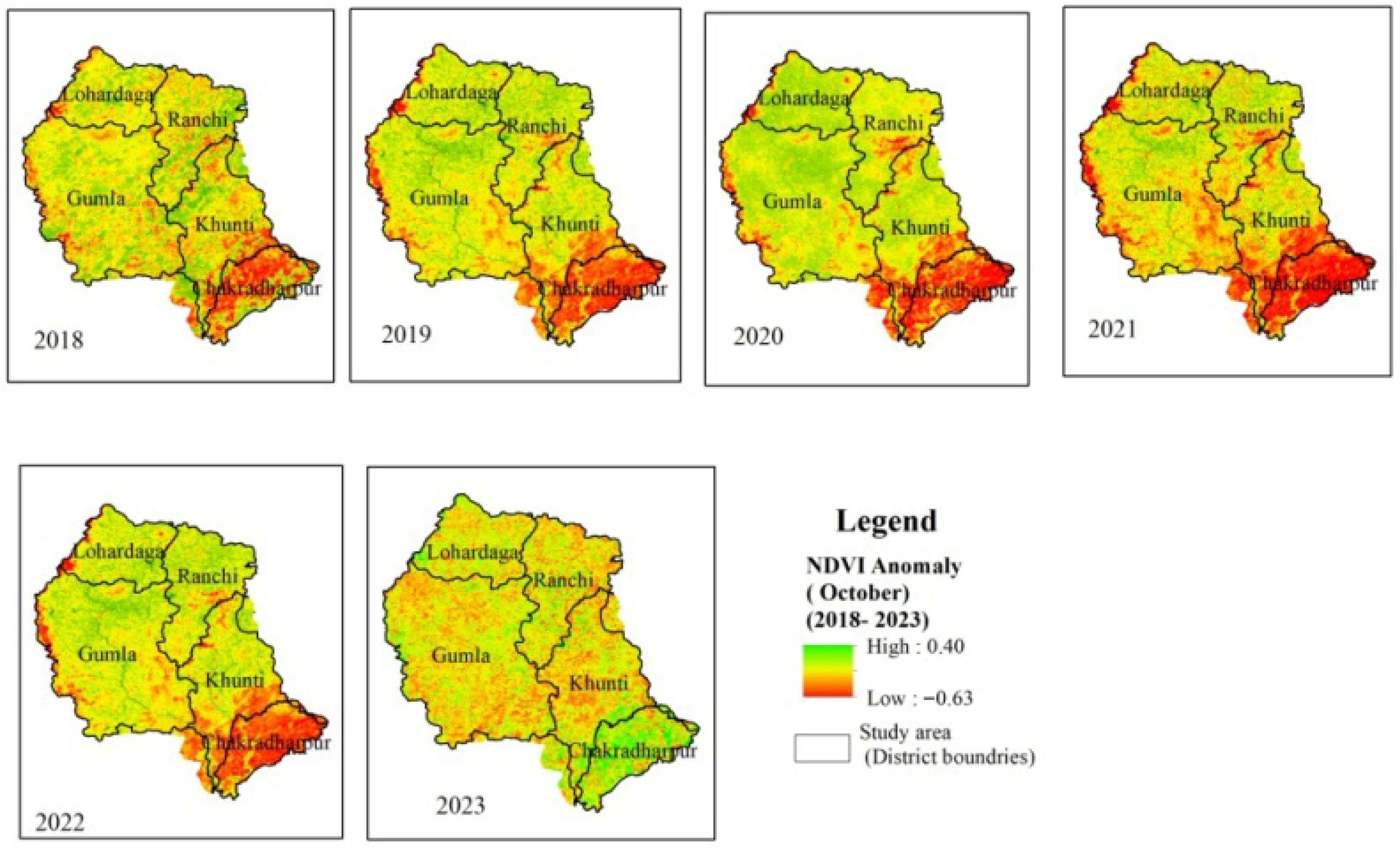
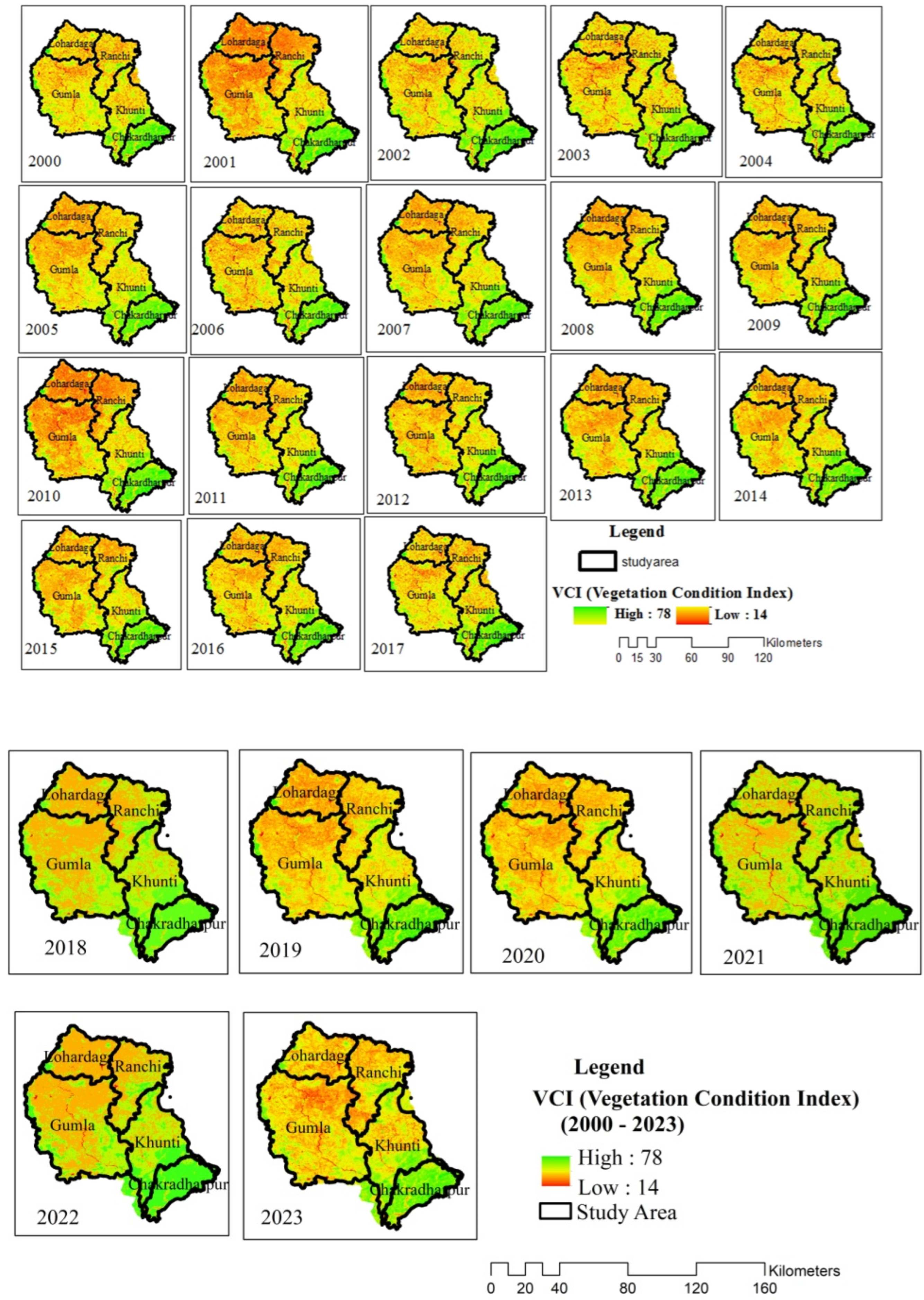

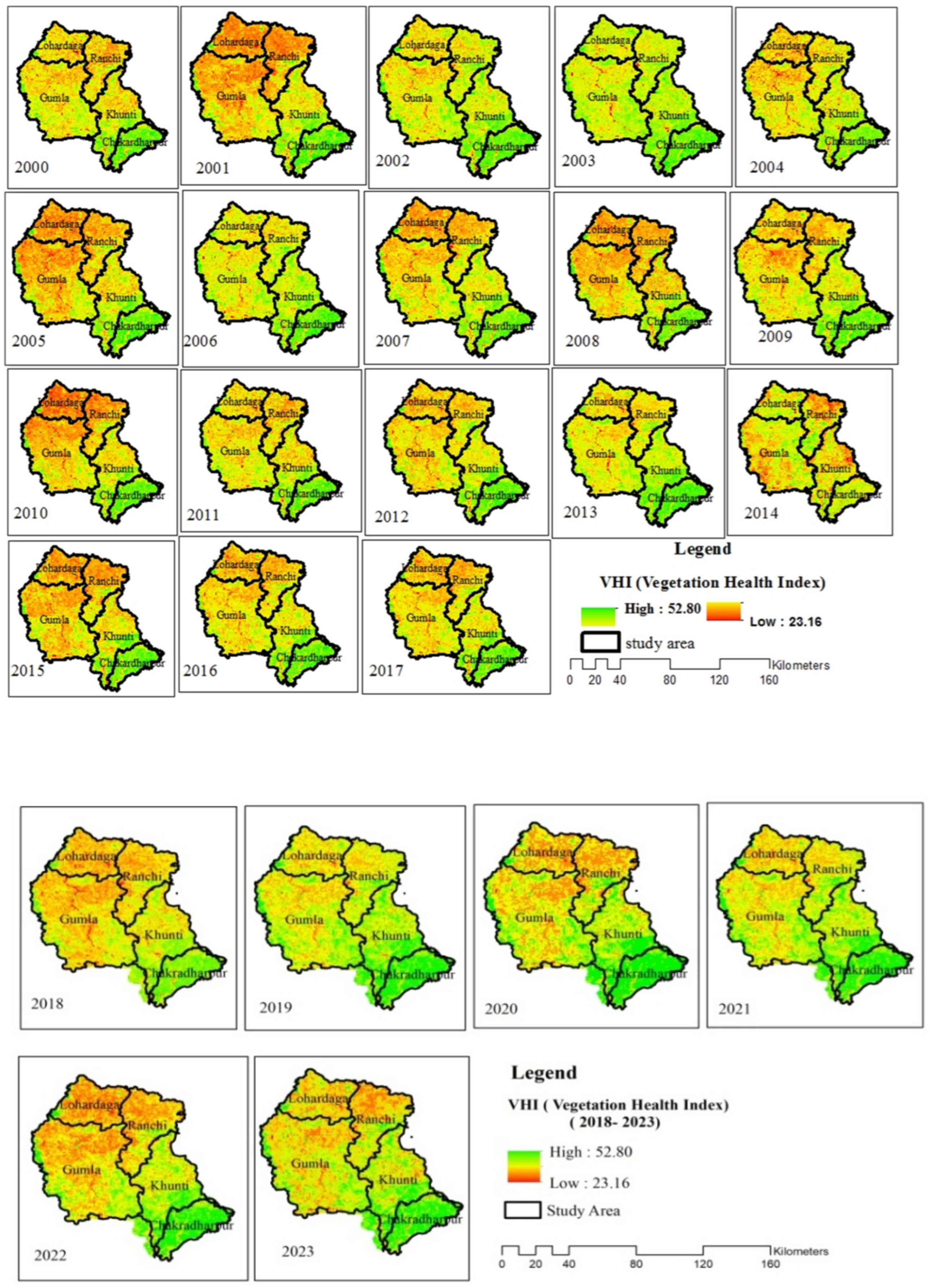
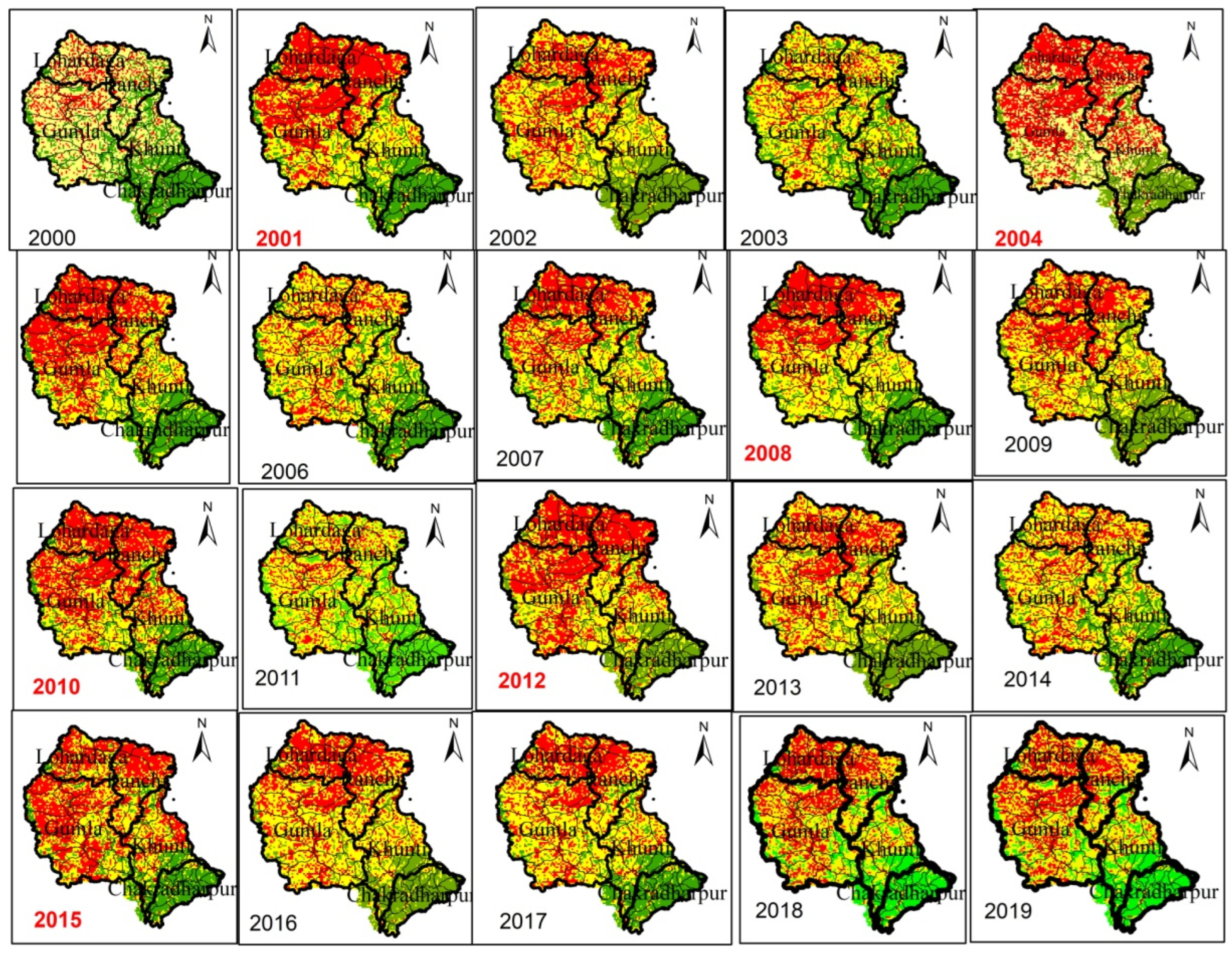
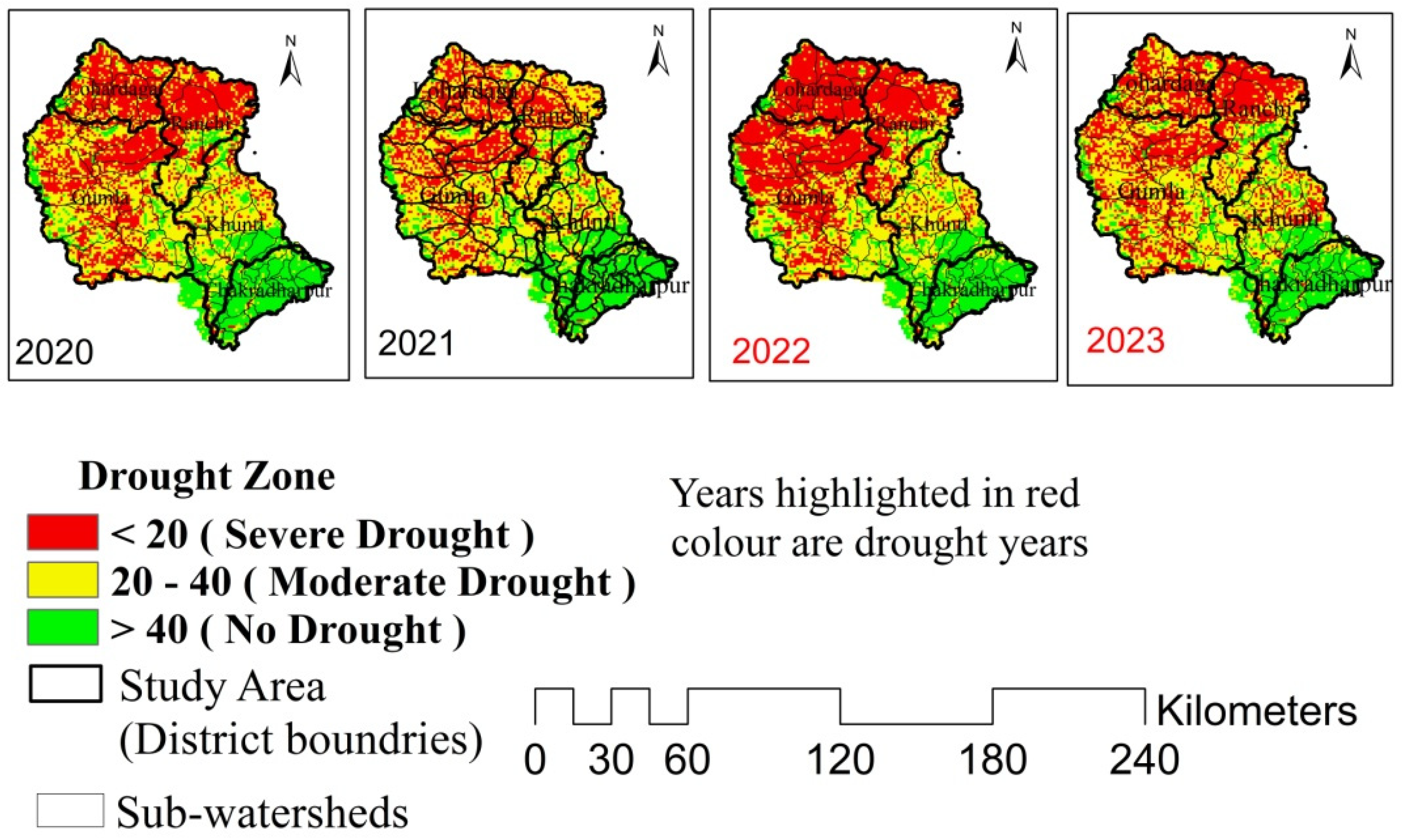
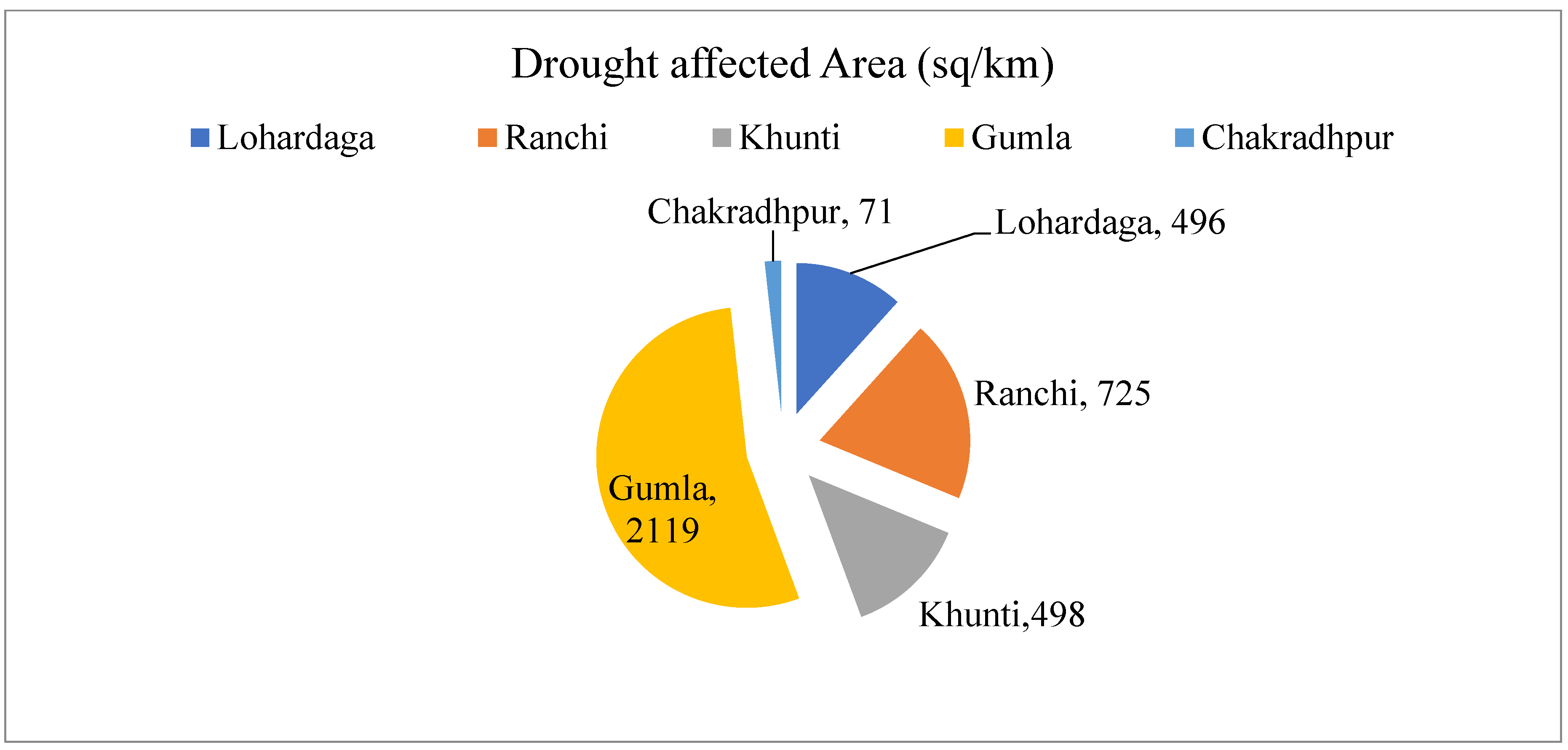
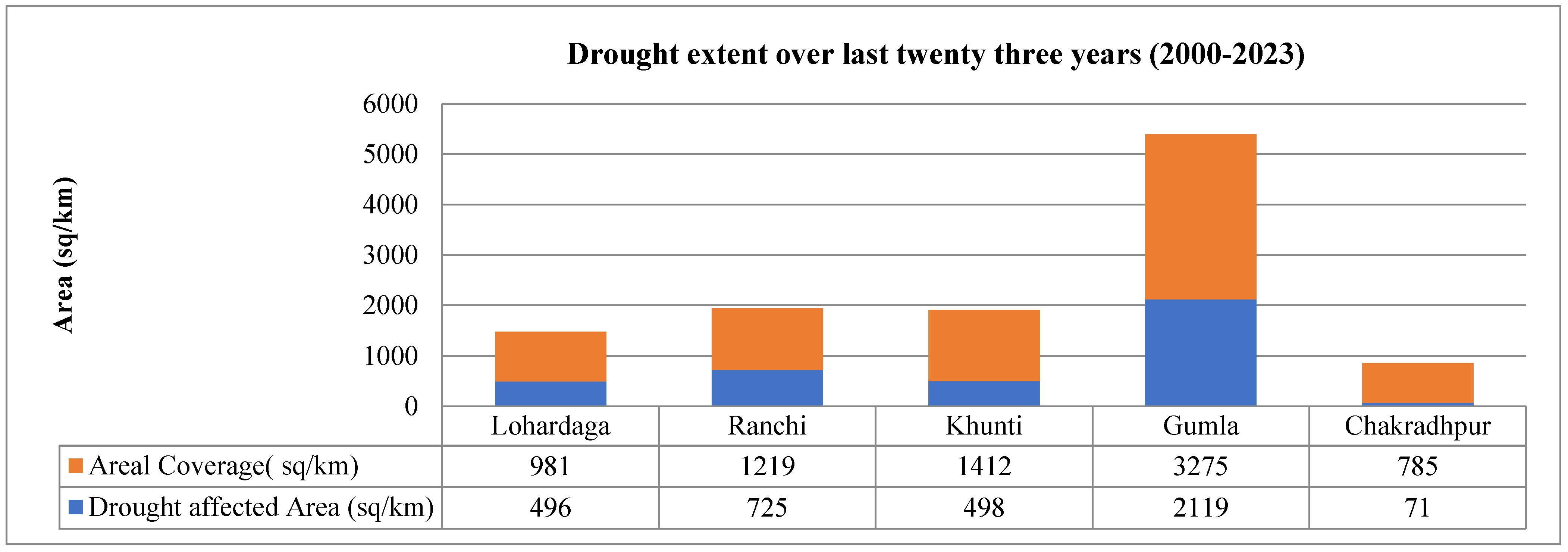


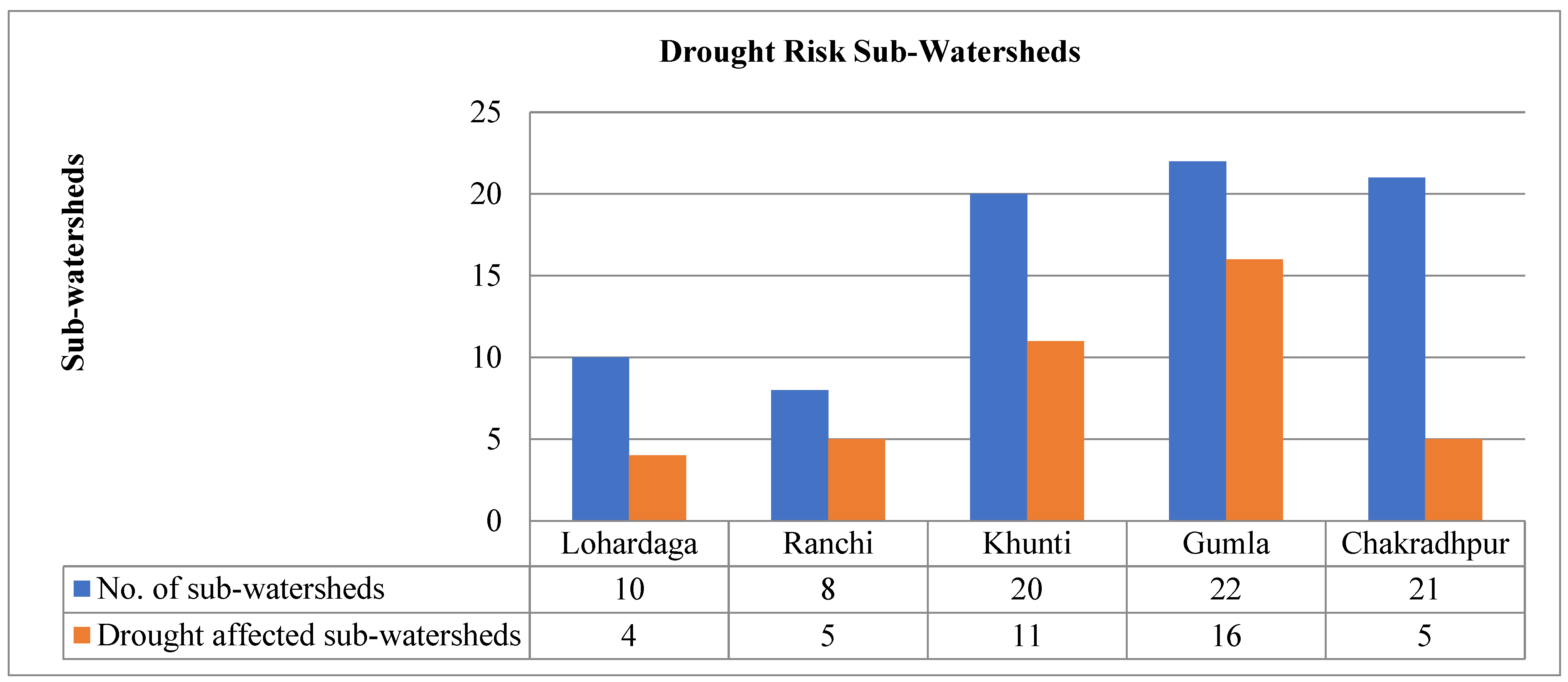

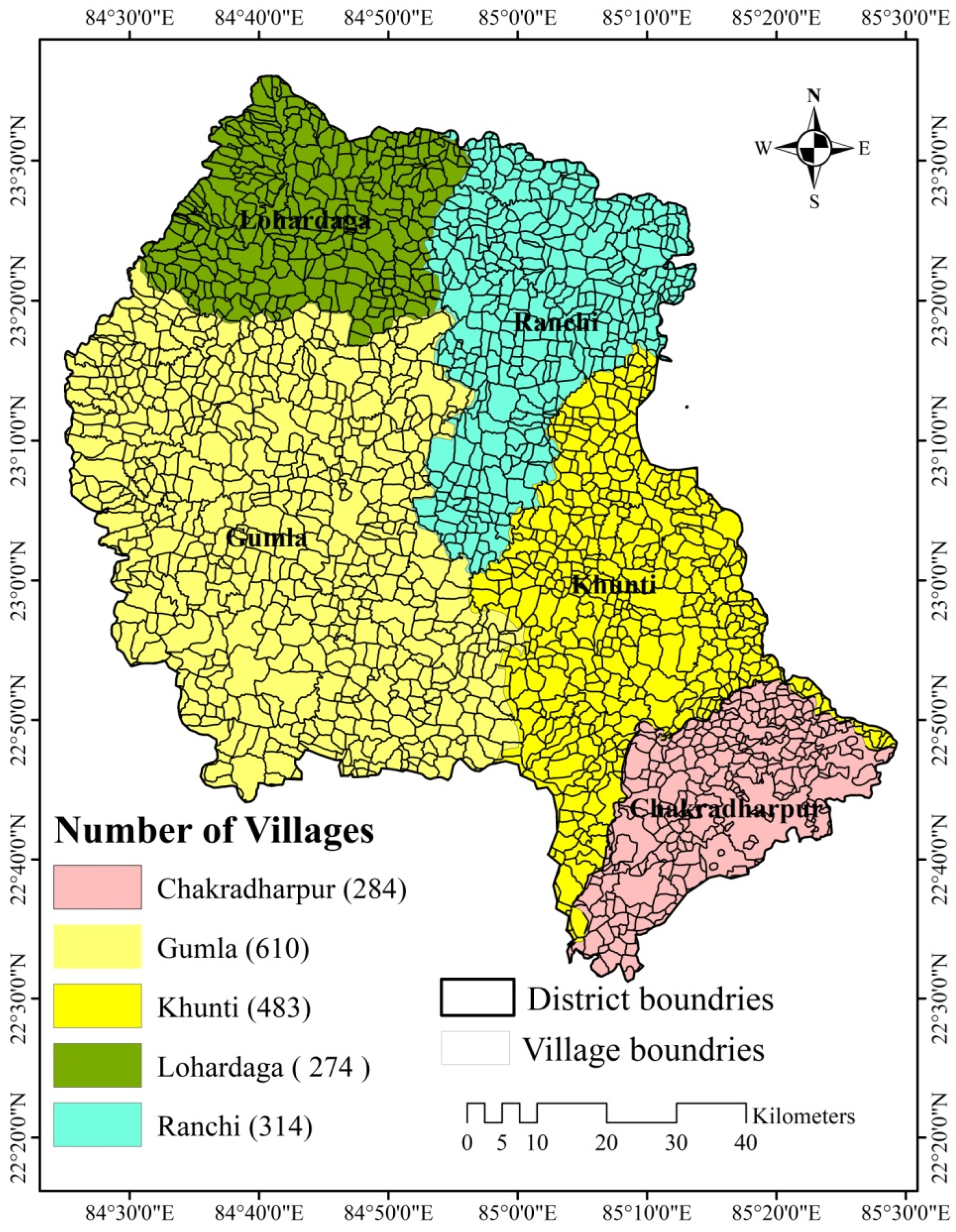
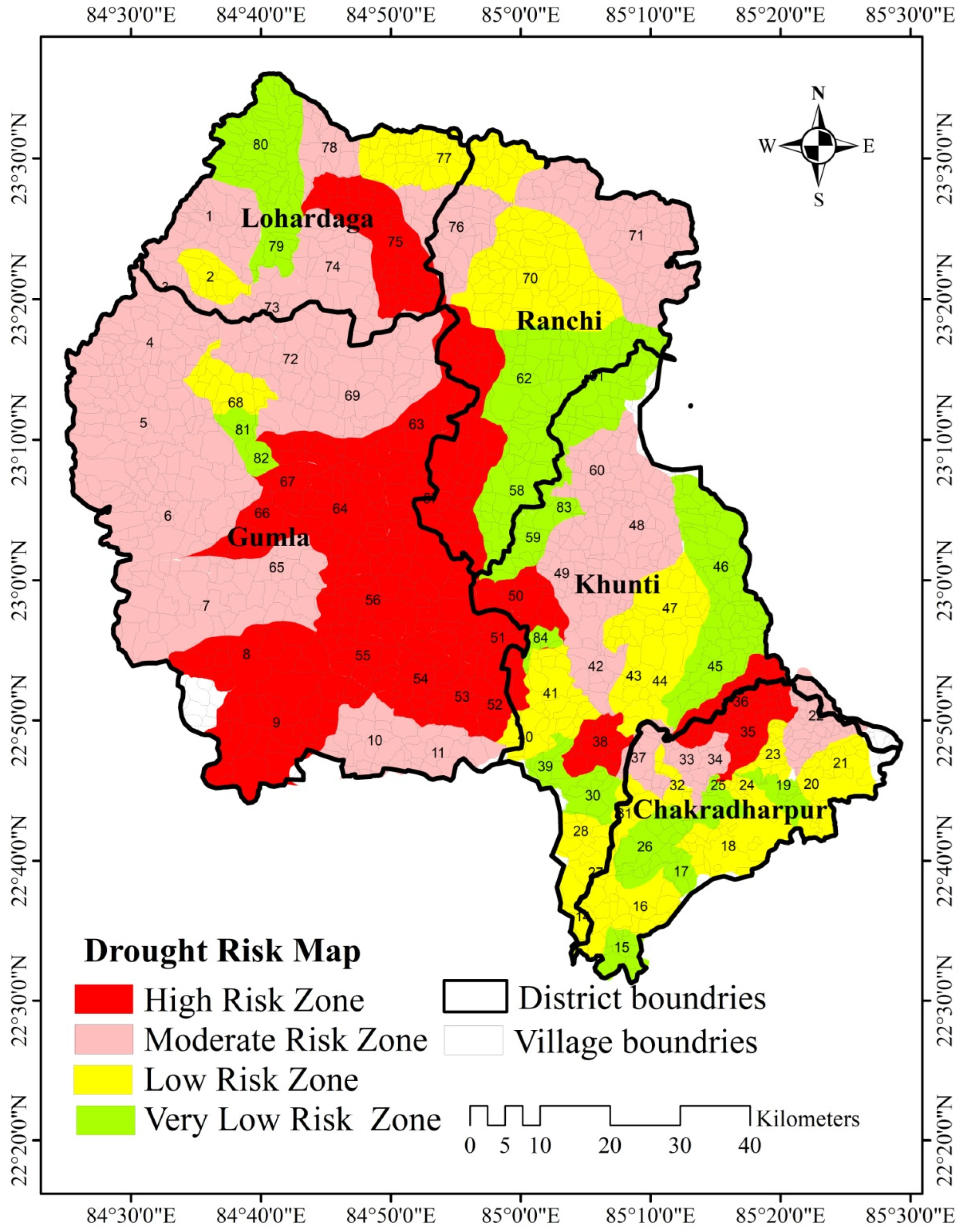
| Indicator | Very Low | Low | Moderate | High | Very High |
|---|---|---|---|---|---|
| Population density ( | ≤600 | 600–1200 | 1200–1800 | 1800–5000 | ≥5000 |
| Household density (house/) | ≤600 | 600–1000 | 1000–1500 | 1500–2000 | ≥2000 |
| Male population (Number) | ≤300 | 300–1200 | 1200–4000 | 4000–8000 | ≥8000 |
| Female population (Number) | ≤300 | 300–800 | 800–2000 | 2000–7000 | ≥7000 |
| Literacy rate (%) | ≤5 | 5.1–12 | 12.1–20 | 20.4–30 | ≥30 |
| Districts | No. of Villages | Areal Coverage (km2) | Population (Persons) | Drought-Affected Area (km2) | No. of Sub-Watersheds | Drought-Affected Sub-Watersheds |
|---|---|---|---|---|---|---|
| Lohardaga | 274 | 981 | 207,236 | 496 | 10 | 4 |
| Ranchi | 314 | 1219 | 352,105 | 725 | 8 | 5 |
| Khunti | 483 | 1412 | 226,097 | 498 | 20 | 11 |
| Gumla | 610 | 3275 | 415,341 | 2119 | 22 | 16 |
| Chakradhpur | 284 | 785 | 18,346 | 71 | 21 | 5 |
| S. No | Prioritizations | Numbers of Sub-Watersheds | Area |
|---|---|---|---|
| 1 | High | 23 | 3652 |
| 2 | Moderate | 19 | 1051 |
| 3 | Low | 24 | 1761 |
| 4 | Very Low | 18 | 764 |
Disclaimer/Publisher’s Note: The statements, opinions and data contained in all publications are solely those of the individual author(s) and contributor(s) and not of MDPI and/or the editor(s). MDPI and/or the editor(s) disclaim responsibility for any injury to people or property resulting from any ideas, methods, instructions or products referred to in the content. |
© 2025 by the authors. Licensee MDPI, Basel, Switzerland. This article is an open access article distributed under the terms and conditions of the Creative Commons Attribution (CC BY) license (https://creativecommons.org/licenses/by/4.0/).
Share and Cite
Chaudhary, S.; Pandey, A.C.; Dwivedi, C.S.; Parida, B.R.; Kumar, N. Agricultural Drought Hazard Using Satellite-Based Indices for Drought Risk Mapping in Koel River Basin (India) Through Geospatial Technologies. GeoHazards 2025, 6, 79. https://doi.org/10.3390/geohazards6040079
Chaudhary S, Pandey AC, Dwivedi CS, Parida BR, Kumar N. Agricultural Drought Hazard Using Satellite-Based Indices for Drought Risk Mapping in Koel River Basin (India) Through Geospatial Technologies. GeoHazards. 2025; 6(4):79. https://doi.org/10.3390/geohazards6040079
Chicago/Turabian StyleChaudhary, Stuti, Arvind Chandra Pandey, Chandra Shekhar Dwivedi, Bikash Ranjan Parida, and Navneet Kumar. 2025. "Agricultural Drought Hazard Using Satellite-Based Indices for Drought Risk Mapping in Koel River Basin (India) Through Geospatial Technologies" GeoHazards 6, no. 4: 79. https://doi.org/10.3390/geohazards6040079
APA StyleChaudhary, S., Pandey, A. C., Dwivedi, C. S., Parida, B. R., & Kumar, N. (2025). Agricultural Drought Hazard Using Satellite-Based Indices for Drought Risk Mapping in Koel River Basin (India) Through Geospatial Technologies. GeoHazards, 6(4), 79. https://doi.org/10.3390/geohazards6040079









